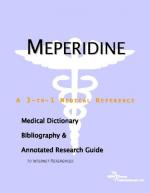|
This section contains 334 words (approx. 2 pages at 300 words per page) |
Meperidine is a totally synthetic OPIOID analgesic (painkiller) with a structure quite distinct from MORPHINE, a natural OPIATE. Unlike morphine's rigid fused ring structures, the structure of meperidine is flexible; it is a phenylpiperidine and bends so that the key portions of the molecule can assume positions similar to those of morphine. A number of other compounds with similar structures are widely used in medicine, including loperamide (used primarily for treating diarrhea) and the extraordinarily potent ANALGESIC agents fentanyl, sufentanil, lofentanil, and alfentanil (for treating PAIN).
Meperidine is a compound with strong analgesic effects similar to morphine's, although greater amounts are needed to produce the same level of analgesia. It is one of the more commonly prescribed opioid analgesics and is better known under one of its brand names, Demerol. Given by injection, 100 milligrams of meperidine equals 10 milligrams of morphine. Meperidine can be administered orally as well as by injection but its potency it not as great following oral administration, so the dose must be increased proportionally. Like morphine, continued use of meperidine is associated with decreased analgesia—TOLERANCE—as well as PHYSICAL DEPENDENCE. As with the other opioids, ADDICTION (defined as a drug-seeking behavior) is not commonly observed with this drug when used for medicinal purposes, but meperidine is highly valued on the street and is widely abused, particularly in its injectable forms.
 Figure 1 Meperidine
Figure 1 Meperidine
Medically, meperidine is a significant problem in patients with kidney conditions, where drug-removal from the body is impaired. Metabolized to normeperidine, a closely related compound, it is eliminated by the kidneys. In patients with kidney problems, this metabolite can accumulate to high levels, which can cloud mental processes and even produce convulsions. Since ELDERLY patients often have impaired kidney function, special care must be taken when using meperidine with them.
See Also
Addiction: Concepts and Definitions; Opioid Complications and Withdrawal)
Bibliography
REISINE, T., & PASTERNAK, G. (1996). Opioid analgesics and antagonists. In J. G. Hardman et al. (Eds.), The Pharmacological Basis of Therapeutics, 9th ed. (pp. 521-555). New York: McGraw-Hill.
|
This section contains 334 words (approx. 2 pages at 300 words per page) |


